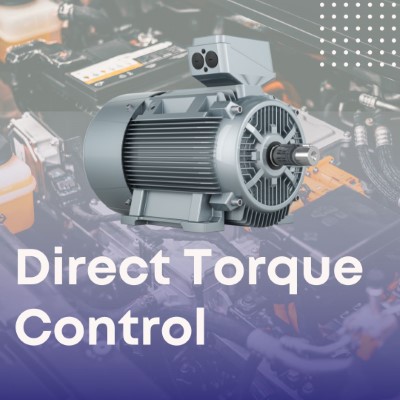What is Direct Torque Control (DTC)?
Direct Torque Control (DTC) is a method used to control the torque and speed of electric motors. Unlike traditional control methods that rely on controlling the voltage or current to manage speed, DTC directly controls the motor’s torque. This method is particularly beneficial in applications where precise torque control is necessary.
Why is Torque Control Required in Electric Motors?
Electric motors are used in various applications that demand different levels of control. Generally, the primary parameter that needs to be controlled is the motor speed. Speed control can be achieved by changing the voltage or current supplied to the motor. However, maintaining a constant speed under varying loads requires feedback systems, either through speed sensors (closed-loop control) or by adjusting the current and voltage (open-loop control).
The Relationship Between Torque and Speed
Torque is directly related to the speed of an electric motor. Higher torque results in higher speed, and controlling torque effectively allows for precise speed control. For instance, in DC motors, torque is proportional to the current if the flux remains constant. This means that by controlling the current, the torque, and consequently the speed, can be controlled. However, this relationship does not hold for all types of motors, such as induction motors or brushless DC motors, where torque might change even if the current remains constant.
When is Direct Torque Control Required?
Direct Torque Control is essential in applications where constant torque is needed regardless of changes in load or other parameters. Some motors, like induction motors, exhibit variations in torque even with constant current. In such cases, DTC is employed to ensure that the torque remains stable, which is crucial for applications requiring precise speed control.
Applications Requiring Constant Torque
In applications where load inertia is low, variations in torque can lead to significant changes in speed. If the application demands that the speed remain constant despite these variations, DTC becomes necessary. Examples include power steering systems in vehicles, where precise torque control ensures smooth and reliable operation.
Impact of Load Inertia
The need for DTC also depends on the inertia of the load. High inertia loads are less sensitive to torque variations, and small fluctuations in torque might not result in noticeable changes in speed. In such cases, precise torque control might not be necessary. Conversely, applications with low inertia loads require DTC to maintain consistent performance.
Hardware Requirements for Direct Torque Control
Implementing Direct Torque Control involves sophisticated hardware and sensors. The primary components include:
Sensors
- Speed Sensors: Used for measuring the motor’s speed.
- Current Sensors: Monitor the current flowing through the motor.
- Voltage Sensors: Measure the voltage applied to the motor.
- Torque Sensors: Directly measure the torque produced by the motor.
Electronic Processors
Advanced electronic processors are needed to handle the extensive calculations required for DTC. These processors use algorithms to estimate torque from voltage and current measurements, allowing for precise control.
Cost and Implementation Considerations
Current and voltage sensors are generally cost-effective and easy to implement. However, speed and torque sensors can add complexity, cost, and reliability issues to the system. In many cases, torque is estimated rather than directly measured to reduce costs and simplify the system.
Direct Torque Control in Different Types of Motors
DC Motors
In DC motors, torque is directly proportional to current, making torque control straightforward by regulating the current. Therefore, DTC is not typically required for DC motors.
Induction Motors and Brushless DC Motors
For induction motors and brushless DC motors, the relationship between torque and current is not as direct. Torque can vary even with a constant current, necessitating the use of DTC to maintain constant torque.
Switched Reluctance Motors
Switched reluctance motors (SRMs) exhibit torque variations due to changes in rotor angle even with constant current. Implementing DTC in SRMs involves adjusting the current to compensate for these variations, ensuring consistent torque output.

Conclusion
Direct Torque Control is a crucial method for applications requiring precise torque and speed control. It is particularly useful in scenarios where traditional methods fall short due to varying load conditions or specific motor characteristics. Understanding the hardware requirements and the specific needs of the application is essential for effective DTC implementation. Whether for industrial machinery, automotive applications, or advanced robotics, DTC provides the precision and reliability needed for optimal motor performance.
